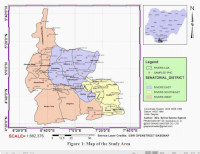Spatiotemporal Mapping of Annual Malaria Incidence in Rivers State, Nigeria. https://dx.doi.org/10.4314/njpar.v44i1.18
Main Article Content
Abstract
Rivers State is the centre of Nigeria's oil industry and has the presence of oil prospectors including expatriates who are at risk of malaria infection. Periodic analysis of epidemiological data will enable malaria control programmers to appraise the interventions carried out over the years and assist in the development of sustainable and adaptive strategies directed from an informed local level. This study, therefore, examined spatiotemporal variations in malaria incidence in the State using Annual Parasite Incidence (API) as an indicator. Monthly reported malaria cases from 2007-2017 at the local government area (LGA) level were retrieved from the Integrated Disease Surveillance Response (IDSR) system of Rivers State Ministry of Health while projected population data for the same period were obtained from the National Bureau of Statistics. API of the LGAs from 2007 to 2017 were computed, integrated into GIS, and subjected to weighted overlay analysis to delineate the risk zones. The eleven-year retrospective study of malaria in Rivers State displayed geographical variations which were statistically significant between the LGAs. Malaria incidence fluctuated throughout the study period. API values increased from 13.746 in 2007 to 34.067 in 2013 and dropped to 8.721 in 2017. All the LGAs recorded API values below 100, indicating a very low malaria burden in a controlled setting. However, none of the LGAs has reached the WHO standard level for the elimination of transmission. Ikwerre, Eleme, Ogu-Bolo and Opobo/Nkoro LGAs were assigned to the very high malaria risk stratum (362.615 to 490.005) whereas Abua-Odual, Akuku-Toru and Degema LGAs were assigned to very low-risk malaria stratum (103.281 to 113.897). The findings of this research will aid stakeholders in evaluating the impact of control strategies employed over the years and possibly, revisit malaria extant interventions for improved malaria control outcomes.
Article Details

This work is licensed under a Creative Commons Attribution-NonCommercial-NoDerivatives 4.0 International License.
References
World Health Organization (2018). Malaria Surveillance, Monitoring & Evaluation: A Reference Manual. https://www.who.int/malaria/publications/atoz/9789241565578/en/.
Kigozi, S. P., Kigozi, R. N., Sebuguzi, C.M., Cano, J., Rutazaana, D., Opigo, J., Bousema, T., Yeka, A., Gasasira, A., Sartorius, B. and Pullan, R. L. (2020). Spatial-temporal patterns of malariaincidence in Uganda using HMIS data from 2015 to 2019. BMC Public Health, 20:1913 https://doi.org/10.1186/s12889-020-10007- w
Ibrahim, M. L., Stephen, M., Okudo, I., Kitgakka, S. M., Mamadu, I. N., Njai, I. F., Oladele, S., Garba, S., Ojo, O.,Ihekweazu, C., Lasuba, C. L. P., Yahaya, A. A., Nsubuga, P. and Alemu, W. (2020). Arapid assessment of the implementation of integrated disease surveillance and response
system in Northeast Nigeria, 2017. BMC Public Health, 20: 600 https://doi.org/10.1186/s12889-020-08707- 4
World Health Organization (2012).Disease Surveillance for Malaria Control: An Operational Manual, 84pp
Pan American Health Organization(2019). Stratification of Malaria Based on Risk of Transmission and Elimination of Foci: Region of the Americas. P16
Hyde, E., Bonds, M. H., Ihantamalala, F. A., Miller, A. C., Cordier, L. F.,Razafinjato, B., Andriambolamanana, H., Randriamanambintsoa, M., Barry, M., Andrianirinarison, J. C. , Andriamananjara, M, N. and Garchitoren, A. (2021). Estimating the local spatio-temporal distribution of malaria from routine health information systems in areas of low health care access and reporting. International Journal of Health Geographics, 20: 8. https://doi.org/10.1186/s12942-021-00262- 4
Oluwafemi, O. A., Babatimehin, O. I., Oluwadare, T. S. and Mahmud, U. M.(2013). Mapping Malaria Case Event and Factors of Vulnerability to Malaria in Ile-Ife, Southwestern Nigeria: Using GIS. Ethiopian Journal of Environmental Studies and Management, 6(4): 365-375
Rivers State Ministry of Health (2010). Rivers State Government Strategic Health Development Plan 2010-2015, p10.
Bhatt, B. and Joshi, J. P. (2019). A spatiotemporal mapping of malaria risk zones integrating Annual Parasite Index and Geographic Information System in Vadodara District, Gujarat (India). National Journal of Physiology, Pharmacy and Pharmacology, 9 (3):221-226
Aladesohun, S. (2019). Nyesom Wike and Rotimi Amaechi: Cousins or strangebedfellows? Retrieved April 05, 2020, from https://www.google.com.ng/amp/s/guardian.ng/politics/nyesom-wike-and-rotimiamaechi-cousins-or-strange-bedfellows/
Tide News online (2014). Rivers State Government set to commission 500 Schools, 70 health centres, honours Lekwot, Isokrari,
and others. Retrieved April 05, 2020, from http://www.thetidenewsonline.com/2014/01/03/rsg-set-to-commission-500-schools-70- health-centres-honours-lekwot-isokrariothers/
O’Meara, W. P., Noor, A., Gatakaa, H., Tsofa, B., McKenzie, F. E. and Marsh, K.(2009). The impact of primary health care on malaria morbidity: Defining access bydisease burden. Tropical Medicine and International Health, 14(1): 29–35.doi:10.1111/j.1365-3156.2008.02194.x
Donkor, E., Kelly, M., Eliason, C.,Amotoh, C., Gray, D. J., Clements, A. C. A., and Wangdi, K. A. (2021). Bayesian Spatio-Temporal Analysis of Malaria in the Greater Accra Region of Ghana from 2015 to 2019. International Journal of Environmental Research and Public Health 2021,18:6080.https://doi.org/10.3390/ijerph18116080
Wangdi, K., Canavati, S. E., Ngo, T. D., Nguyen, T. M., Tran, L. K., Kelly, C., Martin, N. J., and Clements, A. C. A.(2020). Spatial and temporal patterns of malaria in Phu Yen Province, Vietnam, from 2005 to 2016. American Journal of Tropical Medicine and Hygiene, 103 (4): 1540–1548
doi:10.4269/ajtmh.20-0392
Liu, Q., Jing, W., Kang, L., Liu, J. and Liu, M. (2021). Trends of the global, regional, and national incidence of malaria in 204 countries from 1990 to 2019 and implications for malaria prevention. Journal of Travel Medicine, 28(5), https://doi.org/10.1093/jtm/taab046.
Minwuyelet, A. and Aschale, Y. (2021). Analysis of Five-Year Trend of Malaria at Bichena Primary Hospital, Amhara Region, Ethiopia. Journal of ParasitologyResearch,2021,6699373.https://doi.org/10.1155/2021/6699373.
Ma, M., Huang, M. and Leng, P.(2016). Abundance and distribution of immature mosquitoes in urban rivers proximate to their larval habitats.Acta Tropica, 163: 121–129


